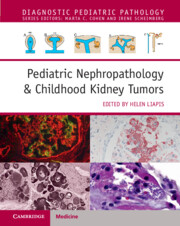Book contents
- Pediatric Nephropathology & Childhood Kidney Tumors
- Diagnostic Pediatric Pathology
- Pediatric Nephropathology & Childhood Kidney Tumors
- Copyright page
- Dedication
- Contents
- Contributors
- Preface
- Section 1 Normal and Abnormal Human Kidney Development
- Section 2 Glomerular Diseases
- Section 3 Tubulointerstitial Diseases
- Chapter 9 Hereditary and Acquired Tubulointerstitial Diseases
- Chapter 10 Tubulointerstitial Diseases with Crystal and Pigment Deposits
- Section 4 Vascular Diseases
- Section 5 Infectious Diseases
- Section 6 Cystic Diseases
- Section 7 Solid Tumors of the Kidney
- Section 8 Transplant Pathology of the Kidney
- Index
- References
Chapter 9 - Hereditary and Acquired Tubulointerstitial Diseases
from Section 3 - Tubulointerstitial Diseases
Published online by Cambridge University Press: 10 August 2023
- Pediatric Nephropathology & Childhood Kidney Tumors
- Diagnostic Pediatric Pathology
- Pediatric Nephropathology & Childhood Kidney Tumors
- Copyright page
- Dedication
- Contents
- Contributors
- Preface
- Section 1 Normal and Abnormal Human Kidney Development
- Section 2 Glomerular Diseases
- Section 3 Tubulointerstitial Diseases
- Chapter 9 Hereditary and Acquired Tubulointerstitial Diseases
- Chapter 10 Tubulointerstitial Diseases with Crystal and Pigment Deposits
- Section 4 Vascular Diseases
- Section 5 Infectious Diseases
- Section 6 Cystic Diseases
- Section 7 Solid Tumors of the Kidney
- Section 8 Transplant Pathology of the Kidney
- Index
- References
Summary
Many entities affect specifically the tubulointerstitium, most often sparing the glomeruli and vessels, but exact subclassification is difficult because the histologic findings may have overlapping features. Frequently biopsies are performed shortly after symptoms manifest (in the acute phase). There is controversy in the terminology of chronic lesions; for example the term chronic pyelonephritis, particularly in the pediatric population, has fallen out of favor, replaced by other terms such as reflux nephropathy. However, careful examination and clinicopathologic correlation helps to pinpoint the cause and guide appropriate patient management. In this chapter, the focus is on the histopathology of acquired and hereditary tubulointerstitial diseases in native kidneys.
Keywords
- Type
- Chapter
- Information
- Pediatric Nephropathology & Childhood Kidney Tumors , pp. 181 - 196Publisher: Cambridge University PressPrint publication year: 2023



